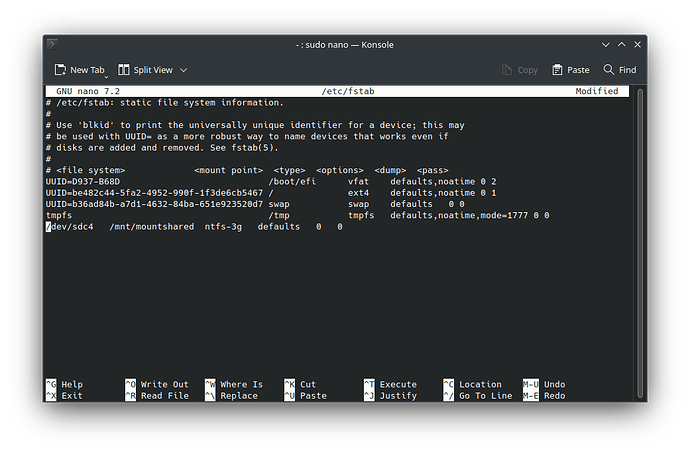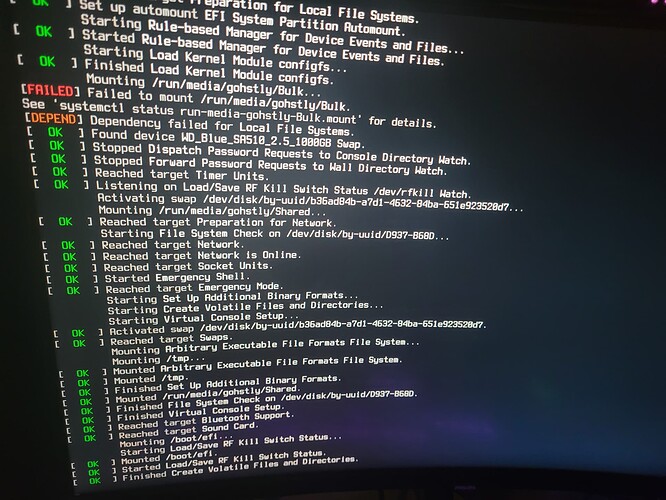I just switched from manjaro to endeavour OS and I seem to be having issues getting endeavour to automatically mount my drives at boot.
I went into removable devices and checked all to mount on login, attempting both each individually as well as all known and both options still require me to click on each drive and log in to each to mount.
What filesystem is on the drives? So we can have a look, post the output of:
lsblk -f
and
sudo parted -l
When you say “log in”, what are you logging in to?
Sorry I meant “enter password” not log in.
The filesystem in question is ntfs and was created on a windows installation.
NAME FSTYPE FSVER LABEL UUID FSAVAIL FSUSE% MOUNTPOINTS
sda
├─sda2 ntfs Bulk Storage 3AF2A34FF2A30E67
└─sda3 vfat FAT32 LINUX BOOT 7854-9717
sdb
├─sdb1
└─sdb2 ntfs Mod Drive 6C3062EF3062BFA6
sdc
├─sdc1 vfat FAT32 BOOT D937-B68D 499.2M 0% /efi
│ /boot/efi
├─sdc2
├─sdc3 ntfs 02F60CCEF60CC3BF
├─sdc4 ntfs Shared Volume 0A62ACB06338C871 199.4G 0% /run/media/gohstly/Shared Volume
├─sdc5 ext4 1.0 Root be482c44-5fa2-4952-990f-1f3de6cb5467 299.5G 8% /
└─sdc6 swap 1 Swap b36ad84b-a7d1-4632-84ba-651e923520d7 [SWAP]
sdd
├─sdd1
└─sdd2 ntfs Emulation Drive A85080DD5080B39A
sde
├─sde1 vfat FAT32 D6DA-7147
├─sde2
├─sde3 ntfs Game Drive CA5EF50D5EF4F2D5
└─sde4 ntfs CAE8F3A1E8F38A49
sudo parted -l output
Model: ATA WDC WD20EZRZ-00Z (scsi)
Disk /dev/sda: 2000GB
Sector size (logical/physical): 512B/4096B
Partition Table: gpt
Disk Flags:
Number Start End Size File system Name Flags
2 135MB 2000GB 2000GB ntfs Basic data partition msftdata
3 2000GB 2000GB 1122kB fat32 boot, esp
Model: ATA WDC WDS100T2B0A (scsi)
Disk /dev/sdb: 1000GB
Sector size (logical/physical): 512B/512B
Partition Table: gpt
Disk Flags:
Number Start End Size File system Name Flags
1 17.4kB 16.8MB 16.8MB Microsoft reserved partition msftres
2 16.8MB 1000GB 1000GB ntfs Basic data partition msftdata
Model: ATA WD Blue SA510 2. (scsi)
Disk /dev/sdc: 1000GB
Sector size (logical/physical): 512B/512B
Partition Table: gpt
Disk Flags:
Number Start End Size File system Name Flags
2 106MB 123MB 16.8MB Microsoft reserved partition msftres, no_automount
3 123MB 354GB 354GB ntfs Basic data partition msftdata
1 354GB 354GB 525MB fat32 boot, esp
5 354GB 730GB 376GB ext4
6 730GB 746GB 16.1GB linux-swap(v1) swap
4 785GB 1000GB 215GB ntfs msftdata
Model: ATA WDC WD10EZEX-75Z (scsi)
Disk /dev/sdd: 1000GB
Sector size (logical/physical): 512B/4096B
Partition Table: gpt
Disk Flags:
Number Start End Size File system Name Flags
1 17.4kB 16.8MB 16.8MB Microsoft reserved partition msftres
2 16.8MB 1000GB 1000GB ntfs Basic data partition msftdata
Model: ATA WDC WDS100T2B0A (scsi)
Disk /dev/sde: 1000GB
Sector size (logical/physical): 512B/512B
Partition Table: gpt
Disk Flags:
Number Start End Size File system Name Flags
1 1049kB 106MB 105MB fat32 EFI system partition boot, esp, no_automount
2 106MB 240MB 134MB Microsoft reserved partition msftres, no_automount
3 240MB 1000GB 999GB ntfs Basic data partition msftdata
4 1000GB 1000GB 512MB ntfs hidden, diag, no_automount
I have too many drives as you can see
One way you can get these frives to automatically mount is to add them to /etc/fstab. Here is the relevant instructive document from the ArchWiki: https://wiki.archlinux.org/title/NTFS-3G#Configuring
Default settings
Using the default settings will mount the NTFS partition(s) at boot. With this method, if the parent folder that it is mounted upon has the proper user or group permissions (e.g. /run/media//), then that user or group will be able to read and write on that partition(s).
/etc/fstab# <file system> <dir> <type> <options> <dump> <pass> /dev/*NTFS-part* /mnt/windows ntfs-3g defaults 0 0
Read through the rest of the article for more advanced configuration options, like setting user- or group-specific permissions.
In a nutshell:
Create a mount point for a drive.
sudo mkdir /mnt/my_cool_mount_point
Edit fstab.
sudo nano /etc/fstab
Add an entry for a drive.
/dev/sda2 /mnt/my_cool_mount_point ntfs-3g defaults 0 0
Make an entry for each of your NTFS partitions you wish to mount from Linux (in your case you may need to set aside a good ten minutes or so because you have so many ![]() ). Then save and exit the file.
). Then save and exit the file.
To immediately mount them after setting up your fstab, reload the daemon:
sudo systemctl daemon-reload
Then mount all devices.
sudo mount -a
If you encounter any errors, paste them into the thread so we can take a look.
Thank you! this works. I just want to know, do I have to edit fstab through nano each time or will kate work just as well?
Edit: seems Kwrite doesnt have the permissions to do so.
I have to ask, does this method move or change any of the file directories for these drives?
Turns out, this isnt an ideal solution. I still dont have file permissions to the drives which I need to access steam games to play through proton. as it seems steam is unable to run proton games without proper file permissions
I do have it installed yes. 2022.10.3-1
Welcome !
You need to change them :
sudo chown -R your_username:your_username /mnt/mountshared
My bad
https://wiki.archlinux.org/title/NTFS-3G#Linux_compatible_permissions
Your id and gid should be 1000, use the id command for confirmation.
chown (and chmod) cannot actually be used to change ownership (and permissions) on non posix file systems. The permissions need to be set in /etc/fstab instead:
https://wiki.archlinux.org/title/NTFS-3G#Linux_compatible_permissions
It seems that i’ve found my answer here.
Though I guess all of these replies are technically solutions.
thank you for the help!
Seem to have encountered an error on boot trying to add another drive to my fstab
How do i fix this?
I wouldn’t use a mount point under /run/media to mount a partition permanently via /etc/fstab.
/run is a temporary filesystem (tmpfs) which is used to store runtime data that are not permanent between reboots.
However systemd seems to recreate a mountpoint under /run/media during boot if there is an entry in /etc/fstab.
I would use the live EnOS’ usb, mount the system partition, make a new mountpoint for the partition in question elsewhere and edit /etc/fstab accordingly.
Also, I think using the UUID (or PARTUUID) in fstab is a more robust way to reference a partition.
https://wiki.archlinux.org/title/Persistent_block_device_naming
I linked that article so you wouldn’t have to do any digging! ![]()
The very next section discusses setting up permissions in your fstab:
Linux compatible permissions
Permissions on a Linux system are normally set to 755 for folders and 644 for files. It is recommended to keep these permissions in use for the NTFS partition as well if you use the partition on a regular basis. The following example assigns the above permissions to a normal user:
# Mount internal Windows partition with linux compatible permissions, i.e. 755 for directories (dmask=022) and 644 for files (fmask=133) /dev/*NTFS-partition* /mnt/windows ntfs-3g uid=*userid*,gid=*groupid*,dmask=022,fmask=133 0 0Alternatively, if the Windows permissions do matter to you, you can use the ntfsusermap(8) command to map Windows users to Linux ones. ntfs-3g will handle the translation of these permissions.
Allowing group/user
In
/etc/fstabyou can also specify other options like those who are allowed to access (read) the partition. For example, for you to allow people in thegroupidgroup to have access:/dev/*NTFS-partition* /mnt/windows ntfs-3g gid=*groupid*,umask=0022 0 0By default, the above line will enable write support for root only. To enable user writing, you have to specify the user who should be granted write permissions. Use the
uidparameter together with your user id to enable user writing:/dev/*NTFS-partition* /mnt/windows ntfs-3g uid=*userid*,gid=*groupid*,umask=0022 0 0If you are running on a single user machine, you may like to own the file system yourself and grant all possible permissions:
/dev/*NTFS-partition* /mnt/windows ntfs-3g uid=*userid*,gid=*groupid* 0 0
That looks like a systemd-mount error. If you aren’t sure what that is, my guess would be it is related to the auto-mount configuration you were trying to set up in the GUI. Perhaps this error is related to your original issue (how the auto-mount was not working through the GUI).
I would choose one or the other, as far as getting the mounts going: either chase down those systemd-mount errors (you could start looking for clues with the suggestion in the error: “run systemctl status run-media-gohstly-Bulk.mount for details”), or work on fixing up the fstab entry so it works with the permissions, etc how you need it to.
If you want to just get rid of that error and push forward with fstab, it is likely all you need to do is undo this effort:
As far as this:
Yes, that looks good. A couple considerations:
- It sounds like you’ll have to add options for permissions, as previously mentioned.
- You may wish to include the
nofailoption. See here: https://wiki.archlinux.org/title/Fstab#External_devices - @pebcak’s suggestion of using the UUID instead of the device identifier is a good one, since how the devices get labeled can change if you add or remove devices. The UUID can be grabbed right out of the
lsblk -foutput above (for example, the UUID of/dev/sdc4is0A62ACB06338C871).
So it would look something like this, depending on what options you decide to go with and the UID/GID you need:
UUID=0A62ACB06338C871 /mnt/mountshared ntfs-3g nofail,uid=1000,gid=1000,dmask=022,fmask=133 0 0

